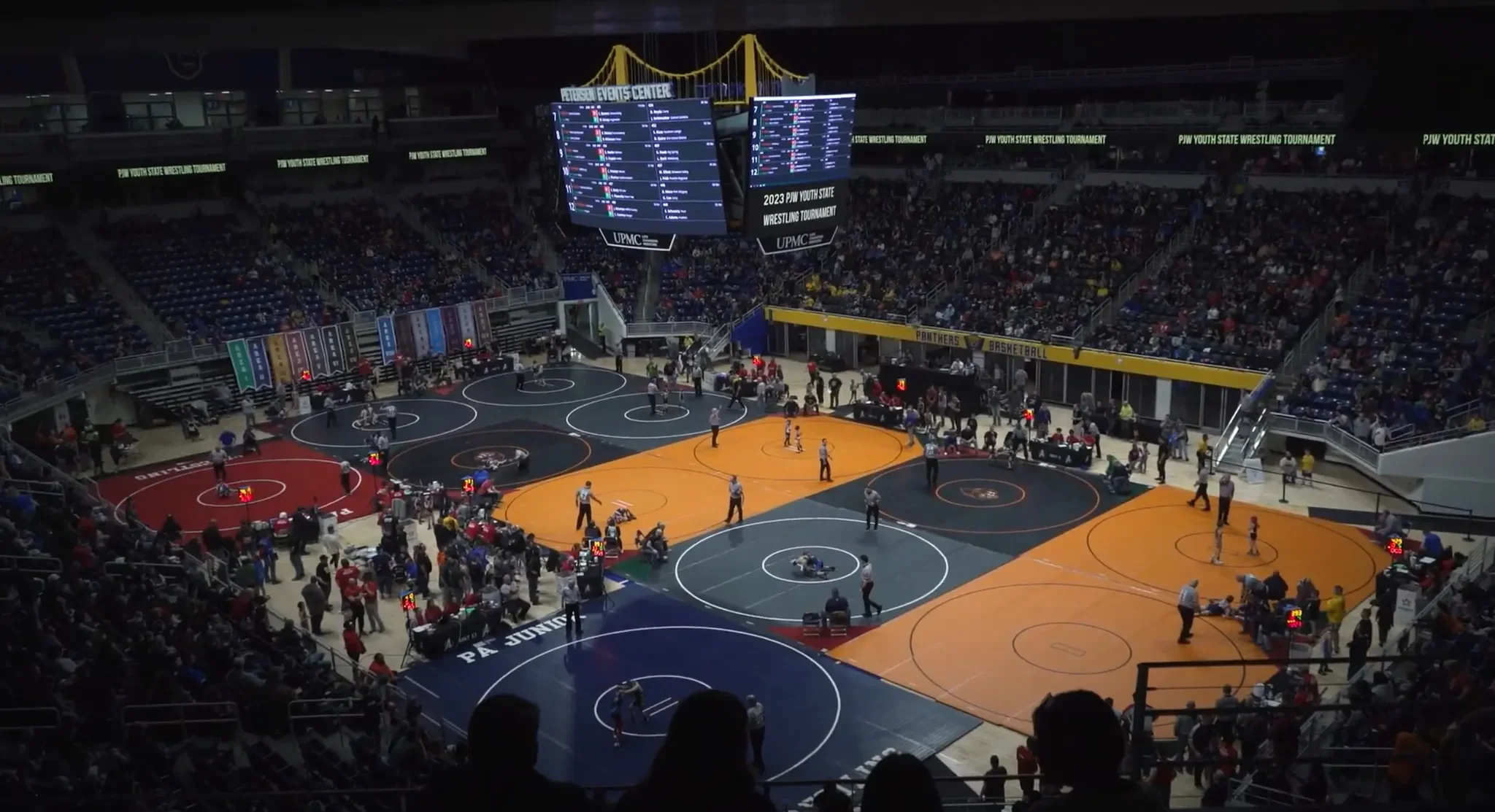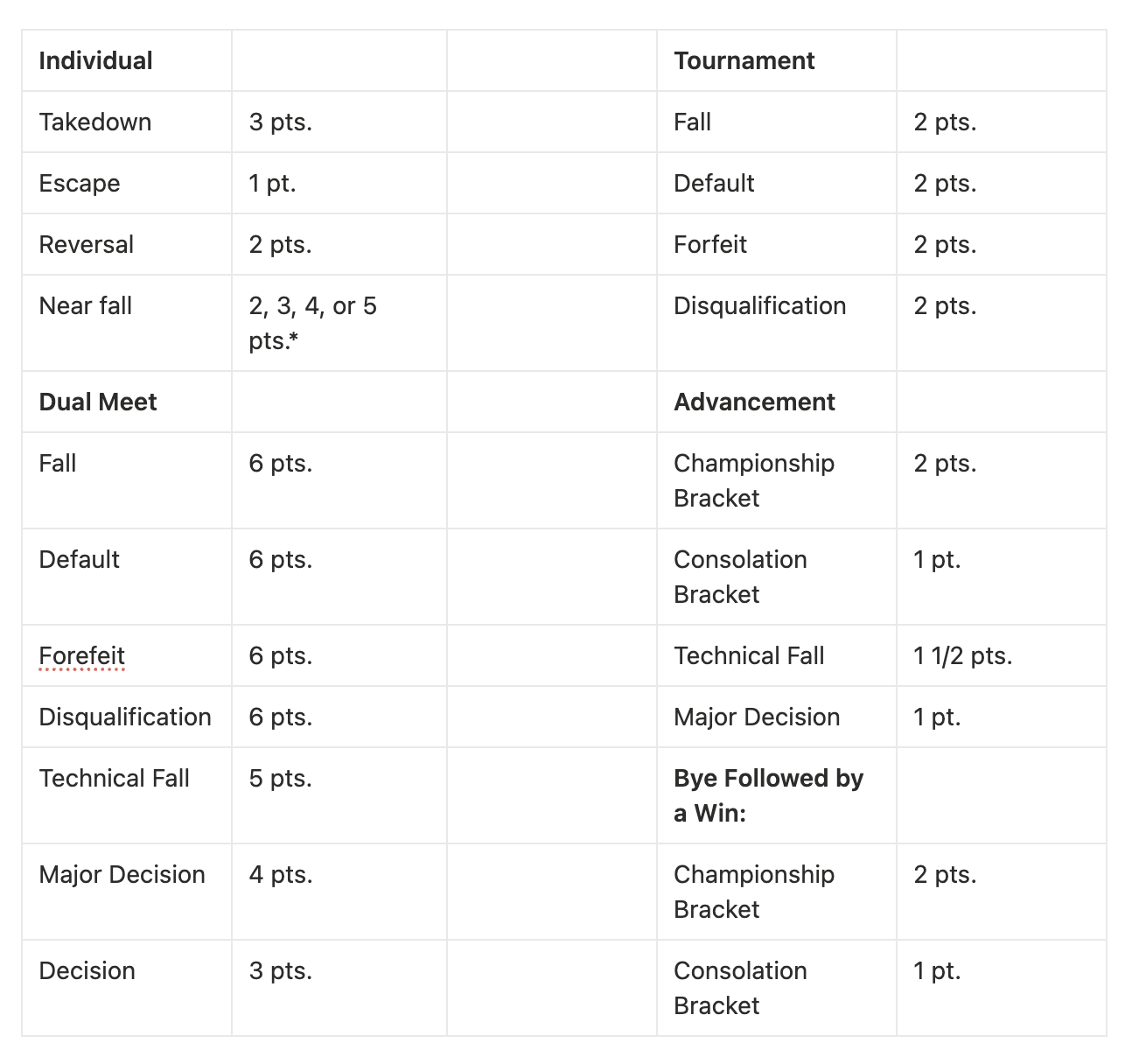Winning
There are three ways to win a wrestling match:
Pin
Points
Default
Winning by Pin
A wrestler “pins’ his opponent by forcing the opponent’s shoulder blades to the mat for two seconds. When the referee signals a pin, the match is immediately over. The wrestler who pins his opponent wins.
Winning by Points
The person who scores the most points at the end of regular time wins the match.
Examples:
At the end of regulation time, wrestler A has 12 points and wrestler B has 9 – wrestler A wins.
At the end of regulation time, wrestler A has 3 points and wrestler B has 1 point, wrestler A wins.
If at any time, one wrestler scores 15 points more than their opponent, the match is stopped and the wrestler with the most points has scored a technical fall. For example: Wrestler A has scored 19 points and wrestler B has 4 points, Wreslter A has scored a technical fall and wins the match.
Overtime
Matches that are tied (or scoreless) at the end of regulation time enter overtime. There are different types of overtime, but the most common is sudden victory. Sudden Victory is another period of similar time frame to the first period. Both wrestlers start in the neutral position, and the first person who scores wins the match.
If the score remains tied at the end of sudden victory, wrestlers continue into additional tie breaker periods and attempt to score points. There are two addition tie breaker periods where each wrestler gets an opportunity to be on top and bottom. Points scored in tie breakers accrue. The wrestler with the most points at the end of the tie breaker periods is declared the winner.
Examples:
The score going into the first tie breaker period is 4 to 4. Wrestler A is on top and wrestler B is on bottom. Wrestler B escapes and earns 1 point. The score is now 4 to 5. The period ends. The second tie breaker begins and wrestler A is on bottom. Wrestler A escapes. The score is now 5 to 5. Wrestler A then scores a takedown and earns 2 points. The score is now 7 to 5. The period ends. Wrestler A wins the match 7 to 5.
If, at the end of the tie breaker periods the score is still tied, the match progresses to a thirty second ultimate tie breaker period. The referee usually starts the wrestlers in top and bottom position, giving the wrestler who scored the first point of the match the choice of position. Again, the first wrestler to score in the ultimate tie breaker wins. If the wrestler on top scores – that wrestler wins. If the wrestler on bottom escapes, he wins. If the wrestler on bottom is not able to escape before the end of the ultimate tie breaker period, the wrestler on top is given 1 point and wins the match,
Winning by Default
A default occurs when one wrestler cannot continue wrestling before the period has run out. When a wrestler defaults, his opponent is declared the winner. There are various types of defaults, including:
Medical default – a wrestler sustains an injury either before or during the match and determines they cannot continue. That wrestler defaults and the opponent wins.
Technical default – when a wrestler commits too many technical violations, they have technically defaulted and their opponent wins (this includes stalling defaults – discussed in more detail below)
Other default – when one wrestler determines for any reason they cannot continue or do not want to continue wrestling they default and their opponent wins.
Scoring Points
There are several ways to score points in wrestling, including:
takedown reversal escape nearfall technical violations stalling cautions Forfeit
Takedowns
A take down occurs when one wrestler takes her opponent from the standing position to the mat and gains control over that opponent. In high school wrestling and below, a takedown scores 3 points.
Reversal
A reversal occurs when a wrestler on bottom is able to regain control over his opponent. A wrestler gains 2 points for a reversal.
For example, from standing (neutral position) Wrestler A scores a takedown on Wrestler B. Wrestler A is now considered in control (aka top or in “advantage”). Wrestler A is awarded 3 points for a takedown. The Match is 3-0. Wrestling continues and Wrestler B performs a switch and takes control back and is on top of Wreslter A. The referee awards Wrestler B a reversal and 2 points. The match is 3-2.
Escape
An escape occurs when the bottom wrestler is able to get free from the top wrestler’s control and back to neutral position. The wrestler who performs an escape earns 1 point.
Example: Wreslter A scores a takedown on wrestler B from neutral position. Wrestler A is awarded 3 points. The score is 3-0. Wrestler B performs a stand-up maneuver is able to get free from Wrestler A and back into neutral (standing) position. The referee awards Wrestler B an escape and 1 point. The score is now 3-1.
Nearfall
Once a wrestler has gained control over her opponent, that wrestler is able to gain nearfall, which happens when the wrestler in control exposes the back / shoulders of the bottom wrestler to the mat at an angle of less than 45 degrees or is closer than 4 inches to the mat for a period of two seconds or longer, continuously. This is also sometimes called back points.
Two seconds of exposure earns 2 nearfall points. 3 seconds of exposure earns 3 nearfall points. 4 or more seconds of exposure earns 4 nearfall points.
The referee will usually hold a number of fingers close to the mat denoting the number of nearfall awarded while the referee checks to see if the wrestler in nearfall is pinned or about to be pinned. The referee usually doesn’t award the nearfall points until the wrestlers come out of the nearfall situation. This is important to remember because the scoreboard may not reflect the actual score until after the wrestlers break nearfall.
Once a Wreslter reaches a 4 count in nearfall they can score no more nearfall points with that same hold. They must work to pin their opponent or change holds and re-enter nearfall to gain more nearfall points. A Wreslter who chains together several moves, each gaining nearfall could rack up 15 or more points in a short amount of time and gain a technical fall over their opponent.
Example:
Wrestler A scores a takedown (3 points) on Wrestler B, and takes him straight to his back for nearfall. After a count of four, wrestler A earns 4 nearfall points, but she does not pin Wreslter B. She lets wrestler B return to his knees and remains in control of wrestler B. The score is now 7-0 with Wrestler A winning. Wrestler A then runs a half Nelson and turns wrestler B into nearfall position gaining 4 more nearfall points. The score is now 11 – 0. Wrestler B recovers to his knees, but as soon as he does, wrestler A gets a cross wrist and rolls through into a tilt scoring 4 more nearfall. The score is now 15-0. The referee stops the match as Wrestler A now has more than 15 points more than her opponent. Wrestler A wins with a technical fall.
Technical Violations and Illegal Holds
There are multiple technical violations and Illegal Holds in wrestling which will stop wrestling activity and incur penalties. Technical violations include:
Intentionally going out of the wrestling area or forcing your opponent out of the wrestling area.
Grasping of clothing, mat, or ear guards
Interlocking or overlapping of hands, fingers, or arms
Leaving the wrestling area without the referees permission
Reporting to the scorer’s table not properly equipped, ready to wrestle, or with any equipment that is detached or illegal.
Wrestlers committing technical violations or illegal holds are penalized as follows.
For the First Offense – 1 penalty point is awarded to the opponent;
Second Offense – 1 penalty point is awarded to the opponent;
Third Offense – 2 penalty points are awarded to the opponent
Fourth Offense – the offending wrestler is Disqualified.
While not technically a technical violation, there are penalties for unnecessary roughness and unsportsmanlike conduct and flagrant misconduct. While these positions are well-defined in the NFHS rule book, they are often called at the discretion of the referee. Wrestling is a sport of respect, and these occurrences are rare, but do happen.
Stalling
Stalling happens when one wrestler does not perform any action or constantly delays action. Clamping up on bottom could be considered stalling. Not shooting and constantly retreating when your opponent shoots in neutral could be considered stalling. While stalling is not a technical violation, it does slow wrestling down and, if done repeatedly, can result in penalty points and even forefeit.
Stalling is penalized in the following way:
For the First Offense – a warning, but no points, is issued.
Second Offense – 1 penalty points is awarded to the opponent
Third Offense – 1 penalty points is awarded to the opponent
Fourth Offense – 2 penalty points are awarded to the opponent
Fifth Offense – the offending wrestler is disqualified.
Cautions
A caution is called when one wrestlers does not take the proper position or moves to motion before the referee signals wrestling can start. In neutral position, a caution could be called when one wrestler shoots on the other before the referee has whistled the match to begin. On top and bottom, a caution could be issues for one wrestler not lining up properly, etc.
For the First Offense – a warning, but no points, is issued. Second Offense -a warning, but no points, is issued. Third and subsequent Offenses – 1 penalty points is awarded to the opponent
Wrestlers cannot be disqualified because of cautions, but frequent cautions can start to add up. They can also result in loss during sudden victory and tie breaker overtime periods.
Forfeit
If one wrestler does not show up for a match or determines they do not want to wrestle for any reason, a forfeit is issues and the other wrestler wins by forfeit.
NFHS Scoring Tables
A list of scoring possibilities for individual matches, dual meets, and tournaments for folk style and scholastic wrestling is shown in the table below from the official 2025-2026 NFHS rules:


